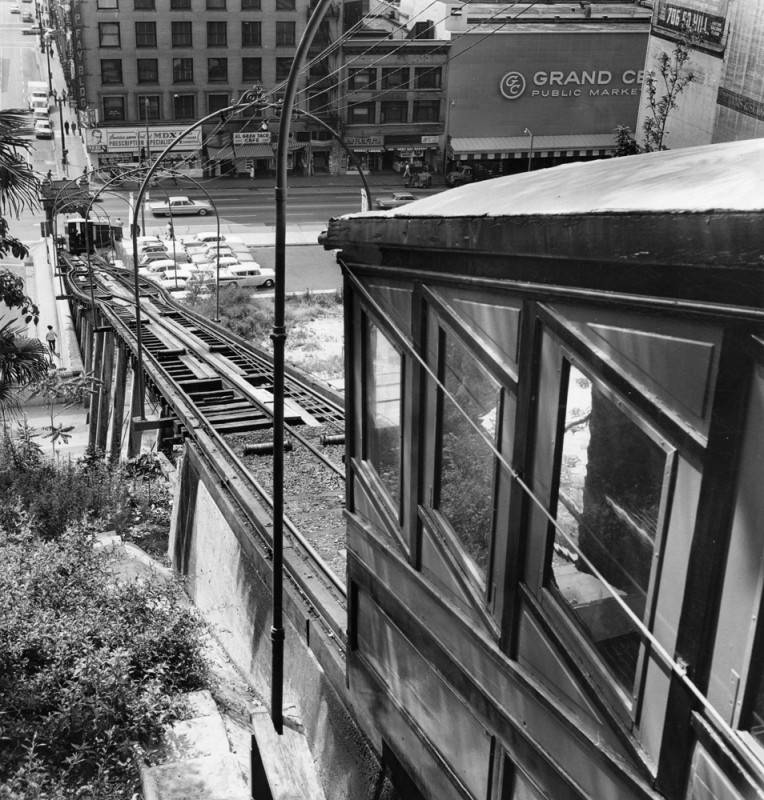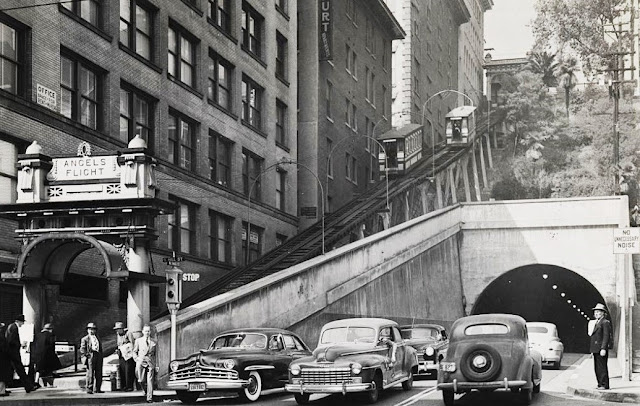Saturday, March 30, 2024
Let's Dance
Tuesday, March 19, 2024
The Herald-Examiner Building, Los Angeles, 1937
 1937, View looking north on Broadway towards Eleventh. Julia Morgan designed the Mission-Revival style Herald-Examiner Building (1111 South Broadway) which opened in 1914. In 1962 the Morning Examiner (founded in 1903) merged with the Evening Herald Express (founded approximately 1871) creating the Herald-Examiner newspaper. The building was designated Los Angeles Historic-Cultural Monument #178 in 1977 and closed in 1989. (Herman J Schultheis Collection) https://buff.ly/3TEpiWC. Thank you to LAPL Photo Collection. Today it's home to Arizona State University.
1937, View looking north on Broadway towards Eleventh. Julia Morgan designed the Mission-Revival style Herald-Examiner Building (1111 South Broadway) which opened in 1914. In 1962 the Morning Examiner (founded in 1903) merged with the Evening Herald Express (founded approximately 1871) creating the Herald-Examiner newspaper. The building was designated Los Angeles Historic-Cultural Monument #178 in 1977 and closed in 1989. (Herman J Schultheis Collection) https://buff.ly/3TEpiWC. Thank you to LAPL Photo Collection. Today it's home to Arizona State University. Devil's Gate Bridge, 1893
Sunday, March 17, 2024
The Pike, 1936
Wednesday, March 6, 2024
Saturday, March 2, 2024
The Hall of Justice, Los Angeles, 1925-
1951, Looking north on Broadway with the Hall of Justice on the right. (Herald Examiner Collection) https://buff.ly/LPy1iai. Thank you to LAPL. Posted Tuesday, March 4, 2025.
Angels Flight, 1901-1969
I'm adding this link to Water and Power's site on Angel's Flight on Thursday, May 9, 2024. It's got a lot of terrific pics of Angel's Flight.
1901, This is the earliest shot of Angel's Flight that I've seen. Thank you to Historic Los Angeles for this photo. It needs to be dated. But this pic was posted on November 27, 2023.
I remember Dad talking affectionately and nostalgically about Angel's Flight and what it was. His basic answer to a kid was: it's a trolley. But I had no sense of the geography of things in downtown Los Angeles as a kid.
1907, Angels Flight funicular at the Third Street tunnel with an observation tower, Downtown Los Angeles (1907). Thank you to Historical Los Angeles, USA. [Posted on Friday, November 1, 2024.]Angels Flight, the iconic funicular railway, transported passengers up and down Bunker Hill from 1901 to the mid-20th century, providing a unique way to navigate downtown’s steep terrain. This 1907 view, it stands near the Third Street tunnel, complete with a lookout tower offering panoramic city views. This charming red trolley became known as the “Shortest Railway in the World,” serving locals commuting to and from the bustling business district below. Angels Flight symbolized the city’s innovative spirit and desire to make urban life more accessible, remaining a beloved Los Angeles landmark to this day.
1909, A Crowd of People Gathered Around the Angels Flight Incline Railway Watching F.R. Pendelton Send His Cartercar Automobile Up the Incline, Los Angeles (1909). Thank you to Historical Los Angeles USA. Posted Sunday, February 2, 2025.
In 1909, a large crowd gathered around the Angels Flight incline railway to witness an unusual sight—F.R. Pendelton sending his Cartercar automobile up the steep tracks. Angels Flight, known as the world’s shortest railway, was designed for pedestrians, but the daring demonstration captured the imagination of onlookers. The event symbolized the growing fascination with automobiles in Los Angeles, a city soon to be defined by its car culture. The incline railway, which connected Bunker Hill to downtown, remained an essential part of daily life for many residents.1910, Third & Hill Street, Angels Flight. Thank you to Historical Los Angeles USA.
During the 1930s, the bustling intersection of 3rd and Hill in downtown Los Angeles was surrounded by shops, cafes, and thriving businesses. This part of the city was filled with pedestrians, streetcars, and the sound of city life, contributing to downtown's role as a commercial and cultural hub. The architecture reflected the era’s styles, with ornate facades and signage adorning each building. As one of Los Angeles' busiest intersections, 3rd and Hill attracted a diverse mix of residents and visitors. Today, the area preserves remnants of its storied past while continuing to evolve with modern developments.
#losangeles #losangelescalifornia #usa #explore #history #historica
1934, Angel's Flight. Thank you to the LAPL Photo Collection.
The funicular railway, known for its distinctive cable-operated cars, was a practical solution to the steep incline of Bunker Hill. The ride was both functional and charming, offering passengers an efficient means of traversing the hilly terrain while enjoying sweeping views of the city. The railway became a beloved feature of Los Angeles, symbolizing both the city’s rapid growth and its embrace of innovative transportation solutions.
The photograph from 1935 captures Angels Flight in its prime, showcasing the two cars that operated on the incline, connected by a cable and driven by a system of pulleys and counterweights. The railway's distinctive appearance, with its ornate ironwork and elegant design, reflects the early 20th-century aesthetic and the importance of integrating functionality with visual appeal.
Also visible in the photograph is the Third Street Tunnel, an engineering marvel of its own time. Completed in the 1930s, the tunnel was a critical infrastructure project designed to ease traffic congestion and improve connectivity in downtown Los Angeles. It served as a vital route for vehicles traveling through the city, complementing the urban landscape and enhancing the overall transportation network.
Angels Flight operated until 1969, after which it was closed and later reestablished in the 1990s in a slightly different location. The Third Street Tunnel, however, continued to serve as an essential part of Los Angeles' transportation system. Both landmarks represent significant aspects of the city's history, reflecting its growth, innovation, and the challenges of urban development.
Today, Angels Flight remains a historical and cultural symbol of Los Angeles, cherished for its heritage and its role in the city’s early 20th-century history. The Third Street Tunnel stands as a reminder of the ongoing evolution of urban infrastructure. Thank you to Walker Man.
| 1940s, Angels Flight from Hill Street. |
Historically, Bunker Hill was a large hill that separated the Victorian-era Downtown from the western end of the city. The hill was tunneled through at Second Street in 1924, and at Third and Fourth Streets. In the late 20th century, the hill was lowered in elevation, and the entire area was redeveloped to supplant old frame and concrete buildings with modern high-rises and other structures for residences, commerce, entertainment, and education.
Note how color strips the scene of its noir charm.
Wikipedia explains that,
The funicular has operated on two different sites, using the same cars and station elements. The original Angels Flight location, with trackage along the side of Third Street Tunnel and connecting Hill Street and Olive Street, operated from 1901 until it was closed in 1969, when its site was cleared for redevelopment.1960, Low-end view of the original Angels Flight with the 3rd Street Tunnel. Thanks to Wikipedia.















.jpg)
.jpg)




.jpg)



.jpg)

















